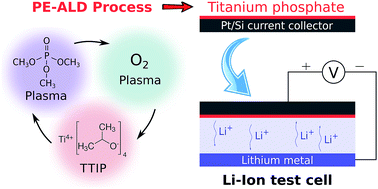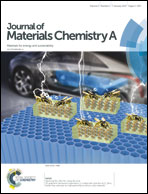Plasma-enhanced atomic layer deposition of titanium phosphate as an electrode for lithium-ion batteries†
Abstract
Titanium phosphate thin films were deposited by a new plasma-enhanced atomic layer deposition process. The process consisted of sequential exposures to trimethyl phosphate (TMP, Me3PO4) plasma, O2 plasma and titanium isopropoxide (TTIP, Ti(OCH(CH3)2)4) vapor, and it was characterized by in situ spectroscopic ellipsometry and ex situ X-ray reflectometry. The growth linearity, growth per cycle (GPC), and density of the resulting thin films were investigated as a function of the pulse times and the substrate temperature. The conformality of the process was characterized by deposition on micropillars. At a substrate temperature of 300 °C and using saturated pulse times, linear growth with a GPC of 0.66 nm per cycle and without nucleation delay was achieved. The as-deposited films were amorphous, while crystalline TiP2O7 was formed upon annealing in air or helium atmospheres. In lithium-ion test cells, the as-deposited films showed insertion and extraction of Li+ around a potential of 2.7 V vs. Li/Li+. Charge/discharge measurements revealed a volumetric capacity of 330 mA h cm−3, together with a good rate capability and minimal capacity fading.



 Please wait while we load your content...
Please wait while we load your content...